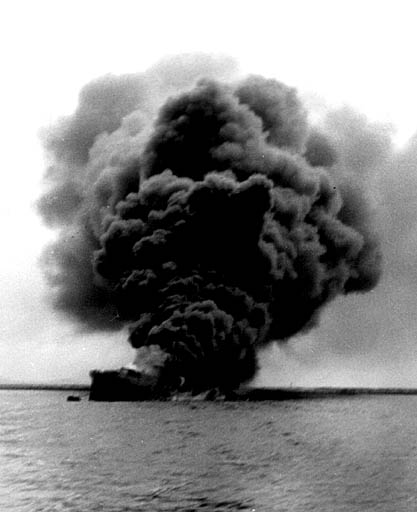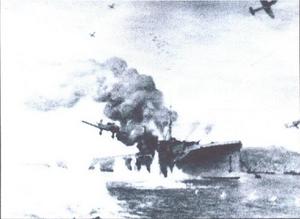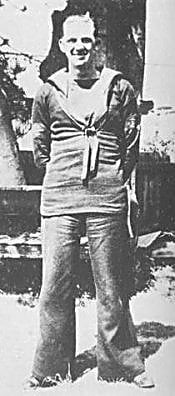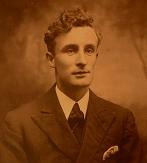
HMS FOYLEBANK. Anti Aircraft Ship – (Excellent detail in Trim: 1940) Also LARN. The wreck was cut in two, one half towed away for breaking in March 1949 and the second was raised and broken up in 1952. See Jack Foreman Mantle VC, Wikipedia.

This story was submitted to the People’s War site by Marie on behalf of Ron Walsh and has been added to the site with his permission. Ron fully understands the site’s terms and conditions.
An official list of Officers and men serving on H.M.S. Foylebank, at the time of the attack on 4th July 1940 states that from a total of 292 Officers and Men aboard H.M.S. Foylebank, a total of 72 people lost their lives, including 14 Officers from an original number of 28!
For his actions during the attack Leading Seaman Jack Mantle was, on 3rd September 1940, awarded a posthumous Victoria Cross, Britain’s highest award for gallantry. His citation reads:
Leading Seaman Jack mantle was in charge of the Starboard Pom Pom when H.M.S. Foylebank was attacked by enemy aircraft on 4th July 1940. Early in the action his left leg was shattered by a bomb, but he stood fast to his gun and went on firing with hand gear only, for the ships electric power had failed. Almost at once he was wounded again in many places. Between his bursts of fire he had no time to reflect on the grievous injuries of which he was soon to die, but his great courage bore him up to the end of the fight when he fell by the gun he had so valiantly served.
* * *
An official report of the action read as follows:
“On the morning of 3rd July 1940 ‘Jerry’ made a further reconnaissance trip taking photographs of Foylebank lying in harbour. The next morning, on July 4th 1940, the sun rose into a cloudless sky and whilst men went about their duties, signals were being received that’ Jerry’ was in the area. It was, and had become, the sort of situation that the men aboard had become acquainted with since arrival in the area. At exactly 0840 hrs ‘Jerry’ was overhead with 26 Ju87 ‘Stuka’ dive bombers of the type first seen used in Spain, and then again as they blasted the armies of Europe into submission, which proceeded to fall screaming from the sky to loose their deadly load on to the ship and its crew. They came at us in formations of 3 & 5 for the next 8 minutes and Foylebank’s guns, those that their crews had been able to man, fought back ferociously. With 22 direct hits her electrics out of action, guns not damaged or destroyed with enough men available, had to be fired by hand.
* * *
Some time after the war, an April 1969, when I had retired from the Royal Navy and was working at H.M.S. Collingwood, Fareham, as a civilian transport driver, I learned that a fellow survivor was attempting to trace survivors of our old ship with a view to starting up an annual Foylebank Reunion to be held on or around the anniversary of 4th July. Peter Davies, from Cheshire, who had been one of Jack Mantle’s gun crew and was badly wounded early on in the action was the man in question.
Around 55 of us answered the copious advertising which Peter had put out in various media all over the UK. During the process I found out that for a couple of years I had been working with fellow survivor, also a civilian worker at Collingwood, in the Officers Training Offices and, of course, I was in the Transport Section. We both lived close to one another close to the base rear gate. His name was Reg Smith and he had been a Leading Telegraphist on Foylebank. From the first re-union we two formed a close bond until he died in 1977.
Shortly after starting the Foylebank Re-Union Club Peter Davies died and Doug Bishop took over and ran it smoothly every year at Portland until diminishing numbers meant that our last re-union was held in 2001 in July. It was our 24th gathering.
As the wreck of H.M.S. Foylebank was lying in 90 feet of water in a strategic position inside Portland Harbour it was essential that she should be salvaged when the war was over. It proved not to be straight – forward for after the battering she had received she had to be brought up in two sections. The forward section was raised in 1947 and broken up in Falmouth, Cornwall. The after section had to have bomb holes patched first and the main engines removed. When afloat ammunition barges were brought alongside and 2,500 rounds of 4 inch shells plus thousands of rounds of smaller calibre bullets were taken off. By the end of April 1952 the stem section had been towed to Grays in Essex and scrapped.
Captain W. R. Fell, R. N. wrote a book called “The Sea Surrenders”, published in 1960. I came upon this volume in which he tells of some of the wartime ships he had been in charge of salvaging including ours and I’m pleased to have permission to quote from his book:
“I left and went to see how things were doing in Portland Harbour. The flak-ship Foylebank, of approximately 6,000 tons deadweight had been sunk during the early years of the war at an important berth in the fleet anchorage. She was in 90 feet of water and lying on most of her damage which was largely situated in the after end. It was impossible to patch her up and lift her in one piece so it had been decided to cut her in half and then try. My predecessor had got the fore end away but the after end was not so easy. When I saw it a gale was whipping short, steep seas across Portland Harbour and it was breaking in showers of spray over the wreck whose upper deck was just above the surface. It was a dismal sight.
On board compressors were running on the highest point of the wreck, supplying four divers with air. They were down in the engine room, the fore end of which was wide open and under water. On deck a party of men was rigging derricks over No’s 4 & 8 hatches.
The holds were one great litter of rotting stores (for her complement of 300 men) ammunition and the odd German bomb that had failed to go off We had to clear the ballast, the mud, the stores, and bombs to make the wreck seaworthy.
The coastal salvage vessel ‘Kinbrace’ was tackling the job and I saw that her crew were really not adequate to the task confronting them. After much trouble I persuaded the Admiralty to let us take on an emergency salvage party of 10 men. Lighters, and barges carrying empty oil drums were brought in an filled with mud which was then taken clear and dumped back into the harbour. Gerry Ransome, an expert burner, who was cutting down the superstructure, let out a yell one day and came running out. “What’s the trouble Gerry?”, I inquired, and he replied, “Nothing really, I just found that instead of dead steel I was burning into live shells and you might get someone to shift them. ” “Not to worry, if they didn’t go off then they wont now”, I told him.”
The divers made and fitted patches for the bomb holes and cut away the decks and gun platforms above the engine room. Once Kilbrace had lifted them clear the dismantling of the main engines was able to commence as they were now accessible. Even after all those years the nuts turned and bolts were withdrawn with ease. Slowly she was coming right.
At the end of February 1952 the main engines were removed down to their crankshafts and we cleared the holds and tested all compartments for water tightness. Thousands of rounds of ammunition, of 4″ machine gun type were got onto barges. All was still knee deep in mud and from the ships living quarters the Hebridean divers had discovered human bones. They downed tools and all bones on board were sought and collected and taken ashore before they would continue. On 31st March Kilbrace was trying to lift the port engine crankshaft and had a weight of about 150 tons on her tackles when instead of raising the crankshaft she raised the whole fore end of the wreck. We got it out a few days later.
On 10th April 1952 Foylebank was towed to a berth in the harbour where much of the ballast was taken out and she rode higher and higher with each load removed. Water was drained from the tunnel flats and bilges and the last parts were removed from her (parts of the engine and ballast) and she was towed to the ship breakers in the Thames, her final journey beginning on 23rd April. The last job of all we had to do was remove 20,000 tins of butter and soggy meat from the refrigerator spaces. We were not sorry to see the last of her!”
(Edited highlights from “THE SEA SURRENDERS”) PERMISSION NEEDED
JACK MANTLE VC
 Leading Seaman Jack Foreman Mantle was in charge of the Starboard pom-pom gun when HMS Foylebank was attacked by enemy aircraft on the 4th of July 1940. Early in the action his left leg was shattered by a bomb, but he stood fast at his gun and went on firing with hand-gear only: for the ship’s electric power had failed. Almost at once he was wounded again in many places. Between his bursts of fire he had time to reflect on the grievous injuries of which he was soon to die but his great courage bore him up till the end of the fight, when he fell by the gun he had so valiantly served
Leading Seaman Jack Foreman Mantle was in charge of the Starboard pom-pom gun when HMS Foylebank was attacked by enemy aircraft on the 4th of July 1940. Early in the action his left leg was shattered by a bomb, but he stood fast at his gun and went on firing with hand-gear only: for the ship’s electric power had failed. Almost at once he was wounded again in many places. Between his bursts of fire he had time to reflect on the grievous injuries of which he was soon to die but his great courage bore him up till the end of the fight, when he fell by the gun he had so valiantly served
Jack Mantle’s Victoria Cross was the only one awarded to the Navy for an act of valour on mainland Britain. He had joined the Navy at the age of 16 and, fittingly, he was buried in the Royal Naval Cemetery, Portland Bill, Dorset.
EDWARD SIDNEY PALMER
 In Memory of Edward Sidney Palmer BEM 1904-1980 Coxswain, Naval Harbourmaster launch in 1940, later Tug Master & Pilot -Awarded BEM for rescue work following attack on AA Ship HMS Foyle Bank in Portland Harbour 4 July 1940 – Courtesy of Eddie Palmer
In Memory of Edward Sidney Palmer BEM 1904-1980 Coxswain, Naval Harbourmaster launch in 1940, later Tug Master & Pilot -Awarded BEM for rescue work following attack on AA Ship HMS Foyle Bank in Portland Harbour 4 July 1940 – Courtesy of Eddie Palmer
She had once been a grain carrier and turned her into a guard ship with anti aircraft guns. Her name Foyle Bank. She used to fly a yellow flag when enemy planes were reported, a red flag when planes were approaching Portland. She also was the quarters of the Reserve Naval ratings. Well on June 4th I was proceeding down the inside harbour at about 08.30 in the morning, a lovely day, a normal day. I noticed the guard ship was flying the yellow flag, but did not take much notice, for she had been flying that on a number of days lately. When out of the sun they came, enemy dive bombers. Diving straight down onto the guard ship, machine gunning and bombing. Hell let loose, about 20 planes, they appeared to have caught us napping. I immediately told my crew that we were going in to pick up the hands and ratings who were jumping and being blown into the water alongside of her. There was a barge with work people alongside of Foyle Bank, a bomb dropped alongside the barge turning it upside down.
We got in alongside started to pick up the survivors and dive bombers kept coming, machine gunning and bombing, lifting the launch almost out of the water. Well we loaded the hands on board until we could not carry any more and made for the nearest jetty. Some of the poor fellows were in a sad mess. We landed as quickly as we could and went back for more. By this time the enemy dive bombers had done what they had come to do, the Foyle Bank was on fire and sinking. She went down later in the day. The Lord looked after us that day.
Well things were happening from that day on, more bombing in Portland and Weymouth. We lived at Chapelhay back in those days, and we got a bashing. Ask your father, he was there. Well on the 28th April 1941 I received a letter from Admiralty, Whitehall stating:
Sir,
I am commanded by My Lords Commissions of the Admiralty to inform you that they have learning with great satisfaction that on their recommendation the Prime Minister has obtained the Kings approval for the award to you of the Medal of the Order of the British Empire, Civil Division, for meritorious service in H M Dockyard, Portland, during enemy air attacks.
Eddie Palmer would also like to acknowledge Mr.Palmer’s shipmates – Messrs. A. V. Bailey (engineer), S. R. Felmingham (A.B.), J. Saunders (A.B.), and J.Pearce (stoker).
Day of Loss: 4
Month of Loss: 7
Year of Loss: 1940
Longitude:
Latitude:
Approximate Depth:
